Beckum yesterday and today
The town of Beckum is nestled in a hilly landscape surrounded by fertile fields, lush meadows and stately forests. The range of hills surrounding the town, the Beckumer Berge, are among the few elevations in the flat Münsterland park landscape.
History of Beckum
Beckum yesterday and today
The town of Beckum is nestled in a hilly landscape surrounded by fertile fields, lush meadows and stately forests. The range of hills surrounding the town, the Beckumer Berge, are among the few elevations in the flat Münsterland park landscape.
In the centre of this elevation is a depression. It naturally forms a spring depression and is the source of numerous streams and ponds. The waters collect here and leave the hilly area to the west as the Werse to enter the Ems and finally the North Sea. The most important streams are the Kollenbach, the Lippbach and the Siechenbach. Their meandering course adorns the Beckum town coat of arms: three silver runs on a red background.
They were also the ones who gave the town of Beckum its name. Bekehem or Bikehem, as the town is called in old documents, means nothing other than Bachheim - the home by the streams, whereby the word ending "-hem" or "-heim" is a typical Carolingian designation. This Bekehem was located at the intersection of two trade routes that led from Münster to Paderborn and from Hamm across the Lippe to Warendorf.
Beckum has had town charter since 1224. However, numerous finds show that there was settlement on Beckum's soil much earlier. Three stone cist graves from the Neolithic period, one of which has been preserved in the south of the town, are among the oldest evidence of human culture in Westphalia.
Significant cemeteries from the Frankish-Saxon period 600-800 AD have been uncovered. In 1861, 61 human burials were discovered in a Frankish cemetery.
Even greater interest was aroused by the uncovered grave of a Frankish prince from the time around 600, who had been buried with rich grave goods. Two precious swords, a throwing spear and richly decorated golden fittings lay in the prince's grave. Ten horse skeletons were discovered at the feet of the dead man.
From the 8th century onwards, the village already had a chapel. It probably belonged to a Carolingian royal court. Beckum is one of the four original parishes of the Münsterland.
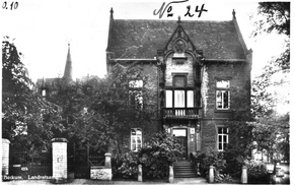
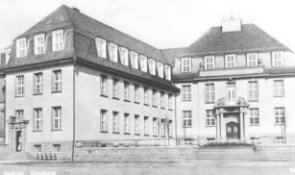
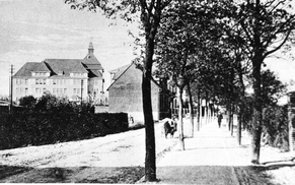
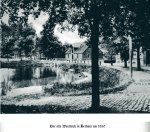
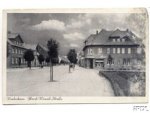

Beckum in the Middle Ages
Merchants, merchants and craftsmen brought considerable wealth to medieval Beckum. Due to its favourable location at the intersection of two trade routes, the town grew rapidly. With more than 2,200 hectares, the town's fields were the largest in the Münsterland region.
The old fortified tower in the Westpark still remains from the strong fortifications. Around 1230, the gold shrine of St. Prudentia was built, according to its size and artistic quality the most important medieval gold shrine in Westphalia. Wars, unrest and the black plague set the town back in the following centuries. It was probably in the context of economic and social decline that the petty crimes known as the "Beckum Attacks" occurred. Several works of art in the town area refer to this.
 Grave goods from the princely tomb
Grave goods from the princely tomb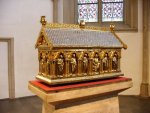 The Prudentia Shrine, Westphalia's most valuable reliquary
The Prudentia Shrine, Westphalia's most valuable reliquaryBeckum in the 19th century
After a long period of economic stagnation, Beckum recovered at the beginning of the 19th century. From 1803 to 1806 Beckum was under Prussian administration, from 1806 to 1813 under French administration.
Beckum becomes a district town in 1816; however, the district administration does not have its seat in Beckum until 1827. The construction of the Cologne-Minden railway gave the town an important connection in terms of transport. The lime and cement industry, which developed in the second half of the 19th century, thus gained an important transport route for its products. In 1872, the first cement plant was founded in Beckum, followed by others, making the Beckum area one of the most important and largest cement districts in the world.
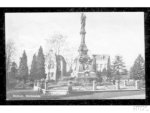 Marienplatz, 1931
Marienplatz, 1931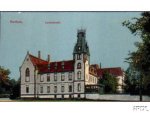 District Office
District Office Weststraße
Weststraße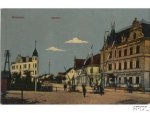 North Gate
North GateBeckum today
The economic boom was brought to an end by the First World War and the inflation that began in 1923. The democratic work of the Beckum town parliament ended in 1933 when the National Socialists came to power. During the Second World War, Beckum was spared major destruction by bombing raids and was handed over to the Americans without a fight in 1945.
After the difficult post-war period, reconstruction proceeded, during which Beckum developed into a modern residential and industrial town. In 1974, the town with the three streams in its coat of arms celebrated its 750th anniversary. Today Beckum belongs to the district of Warendorf and has a population of about 37,000 including the districts of Neubeckum, Vellern and Roland. Numerous hiking trails and recreational areas make Beckum a popular destination for short breaks.
1999 was a special year for Beckum. At that time, Beckum had been a town for 775 years. Various (smaller) events were held to commemorate this anniversary. However, the 100th anniversary of Neubeckum, which took place at the same time, was celebrated in the foreground.
 City festival "Pütt Days
City festival "Pütt Days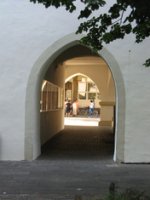 Passage from St. Stephen's Church to the Market Square (Immig)
Passage from St. Stephen's Church to the Market Square (Immig)Beckum's beautiful daughter Vellern
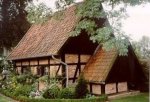 The bakehouse in the centre of Vellern
The bakehouse in the centre of Vellern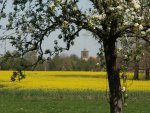 View of Vellern
View of VellernHanse
Beckum and the Hanseatic League
The Westphalian agrarian town of Beckum was a member of the large medieval merchant league of the Hanseatic League. The town's citizens played an active part in the widespread trade, which mainly extended to the North Sea and Baltic regions. The oldest reference to Hanseatic activities is the will of the Beckum merchant Gerhard Schuttorp, who died on a trading trip to Stockholm in 1433. In 1438 we learn of the Beckum merchant Cord Grotehues, who was on his way to the Hanseatic Kontor in Bergen.
The historical sources show that citizens of Beckum participated in Hanseatic trade from the 15th century at the latest, and were also admitted to the four large Hanseatic trading centres in Bergen, Bruges, Novgorod and London.
The Hanseatic League as a federation of North German cities developed from individual merchant cooperatives and smaller Hansen, derived from the Germanic hansa = crowd, cohort. These Hansen were protective organisations for German merchants trading abroad. They monitored acts of violence against the merchants, controlled taxes, customs duties, weights and measures, settled disputes and only allowed their own merchants to enter the markets.
The association of merchants soon changed into an association of towns. From 1358 onwards, there is the first mention of the "steden van der dudeschen hense". This comprised about 70 - 80 active member towns and about 100 - 120 smaller towns that were members of the Hanseatic League. The first Hanseatic League meeting probably took place in 1366.
The cities of Dortmund, Soest, Münster and Osnabrück formed the so-called "Westphalian quarter of the Hanseatic League" under the domination of Cologne. In Riga there was the "large or merchants' quarter of Münster" and the "small or craftsmen's quarter of Soest".
In 1572, the Münster Hanseatic Quarter was divided into two sub-quarters, the Braem Quarter (up'm Brahm) with the headmaster town of Coesfeld and the Drein Quarter (up'm Drein) with the suburb of Warendorf. The Braem quarter included the Hanseatic towns of Bocholt, Borken, Dülmen, Haltern and Vreden, while the Drein quarter included Ahlen, Beckum, Rheine, Telgte and Werne.
The Hanseatic League's trade in goods made the Münsterland an important transit area between the trading metropolis of Cologne and the seaside towns on the North and Baltic Seas. Of the numerous north-south trade routes, one important route led via Osnabrück, Warendorf and Beckum to Soest; another from Münster via Hamm to Werl. The Schleswig riders from Soest, for example, will have travelled via Beckum. These merchants from Soest had their privilege over the herring trade confirmed by the Danish king in 1232. In addition to bulk fish, other imported products came to Westphalia: Wine, porst (wild rosemary), hops and other brewing products as well as furs, wax, potash. The counter-cargo exported from Westphalia consisted mainly of canvas, livestock products, grain, beer and - from the southern parts of the country - metal products.
To what extent Beckum participated in Hanseatic trade we can no longer determine today. In the heyday of the Hanseatic League, Beckum had a good economic structure and was not dependent on long-distance trade of its products. It probably seemed sufficient to participate to a certain extent in the trade in goods which the two Hanseatic long-distance trade routes allowed to flow through the town anyway. The representation of the Hanseatic claims was obviously left to the suburb of Warendorf, to which Beckum was subordinate as a Hanseatic by-city. In addition to its function as a suburb, Warendorf also had considerable advantages over other country towns due to its access to the navigable Ems.
The demarcation between Hanseatic and non-Hanseatic towns was always fluid. From the 15th century onwards, the Hanseatic towns complained increasingly that the trading privileges they had paid dearly for were also being used by non-Hanseatic towns and villages. Of all the Hanseatic towns, only 14 were still prepared to pay their dues in 1604. In October 1619, Münster demanded the contributions of its neighbouring towns in the Braem and Drein quarters for the last time.
Sensitive restrictions on maritime trade had already resulted around 1400 from the piracy of the Vitualienbrüder under Störtebeker and Michels (their buccaneering multiplied the price of salt herrings in 1394/95), but above all from the advance of English and Dutch merchants in the 15th century. The viability and internal dissolution of the old merchants' association, which was no longer given anyway, was accelerated by the Thirty Years' War (1618 - 1648).
However, this by no means meant a decline in trade, but merely its transformation. Westphalia benefited in particular from its geographical proximity to the Netherlands, which experienced its heyday in the 17th century. Like England and Spain, the Netherlands were strongly oriented towards maritime trade and shipping. The neglect of their own trade and the natural lack of raw materials meant good export opportunities for Westphalian goods.
The last Hansa Convention took place in Lübeck in 1669 and ended inconclusively. With this, the medieval trade alliance was finally extinguished. The three cities of Bremen, Hamburg and Lübeck, however, maintained their tradition as Hanseatic cities in their city names.
The new Hanseatic League
DIE HANSE is an active network of cities that historically belonged to the alliance of merchant cities, i.e. the historical Hanseatic League, or had a lively trade exchange with these cities. This association of cities was founded in 1980 in the Dutch city of Zwolle and has since become the world's largest voluntary association of cities.
Every year, an international Hansa Convention is held in one of the member cities. For the young people there is the project "Youth Hansa". The Hanseatic Office is based in Lübeck. Each member city sends delegates to the so-called delegates' conferences. The town of Beckum is also a member of the "New Hanseatic League".
Homepage of the New Hanseatic League
Westphalian Hanseatic League
Beckum is also a member of the Westphalian Hanseatic League, an association of currently 48 towns founded in 1983.
Stumbling blocks
Setting a sign against forgetting
Westdeutscher Rundfunk (WDR) has listed more than 15,000 Stolpersteine in NRW in an app and an accompanying website. Among them are the Beckum Stolpersteine.
https://stolpersteine.wdr.de/Pressemitteilung for the WDR campaign
By laying a total of 32 "Stolpersteine" (stumbling stones), the town of Beckum is helping to keep the memory of the mostly Jewish victims of National Socialism alive in Beckum.
The "Stolpersteine" campaign was initiated by the artist Gunter Demnig. Since 2003, more than 300 towns in Germany as well as in Austria, Hungary and the Netherlands have participated in the project, thus setting a sign against forgetting, but also against nationalism and extremism.
The "Stolpersteine" in Beckum are also such a sign. It is gratifying that the project is supported by many citizens. The stones were completely financed by donations of about 3,000 euros, which were given by many individuals, house owners, but also by school classes, political parties and associations. The lively participation in the information event held in advance and in the laying of the stones also demonstrated the interest of the citizens.
The council of the city of Beckum supports the "Stolpersteine" campaign and accepts the offers of citizens and various associations and groups to take on sponsorships. On 27 September, the Beckum City Council passed the following resolution: "The administration is instructed to initiate and coordinate all necessary steps with the aim of carrying out the "Stolpersteine" campaign in 2007. On 13 March 2007, Gunter Demnig laid the first Stolpersteine in Nordstraße. On 5 June 2008, the "Stolpersteine in Beckum" campaign was continued. Gunter Demnig lays two stones in front of the house at Nordstraße 8
Gunter Demnig lays two stones in front of the house at Nordstraße 8 Stumbling block laying in 2007
Stumbling block laying in 2007 Louis and Therese Rose lived until their deportation in 1942 in what was then the Jewish community centre, behind which the synagogue was located until the Reichsprogromnacht.
Louis and Therese Rose lived until their deportation in 1942 in what was then the Jewish community centre, behind which the synagogue was located until the Reichsprogromnacht. Many Beckum residents took part in the laying of the Stolperstein
Many Beckum residents took part in the laying of the StolpersteinWhat are "stumbling blocks"?
The artist Gunter Demnig commemorates victims of the Nazi era by placing brass memorial plaques in the pavement of the street or pavement in front of their last self-chosen place of residence. "A person is not forgotten until their name is forgotten," says Gunter Demnig. With the stones in front of the houses, the memory of the people who once lived here comes alive. It is written on the stones:
HERE LIVED... One stone. A name. A person.
"Stolpersteine" ...
- are concrete cubes the size of paving stones that are set into the pavement in front of the houses or properties of former Jewish residents,
- bear a brass plaque with the inscription "Here lived ... Deported ... Murdered in ...".
- commemorate expulsion and extermination under the Nazi regime,
- mark the beginning of the path that ended in the extermination camp,
- draw attention to the individual fate,
- are to be "committed",
- are also art in public space,
- are laid with the consent of the Central Council of Jews and the Yad Vashem memorial,
- are financed through sponsorships from citizens' initiatives, associations, schools, descendants of victims and other individuals.
Homepage of the Stolpersteine campaign
Stumbling blocks are located in front of the houses:
- Alleestrasse 7
- Alley road 35
- Clemens-August-Straße 1
- Clemens-August-Straße 5
- Lippweg 7
- Lippweg 23
- Neubeckumer Street 15
- North road 8
- North road 11
- North road 16
- Nordstraße 19
- North road 24
- North road 32
- North road 34
- North road 52
- Oststraße 12
- Oststraße 13
- Oststraße 14
- Oststraße 35
- Vorhelmer Street 13
- Weststraße 19
- West Road 32
The Beckum Stumbling Stones were laid in 2007 and 2008 and were partially corrected and supplemented in 2022 and 2023.
All the facts about the Stolpersteine in 2007 and 2008 have been summarised in a detailed documentation: Documentation "Stumbling Stones Beckum"
Further information is available on the website of the Heimatverein Beckum: https: //www.heimatverein-beckum.de/stolpersteine.html
Honorary citizens
Rudolf Dunker, Dr Max Hagedorn and Heinrich-Gerhard Bücker
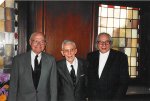
... were the last three in a whole series of honorary citizens of Beckum. They have rendered outstanding services to Beckum. The photo (right) was taken at the reception of the city of Beckum on the occasion of Dr. Max Hagedorn's 90th birthday.
Rudolf Dunker
born 13.05.1916, died 29.09.2008
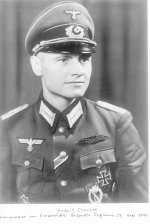
It was mainly thanks to Rudolf Dunker's responsible and courageous actions that the town of Beckum was peacefully handed over to the US forces on 1 April 1945.
As combat commander of the German Wehrmacht in Beckum, the then 28-year-old had the mission to defend the town of Beckum to the last man. Thus, on Good Friday, 30 March, he began to prepare the resistance against the Allied forces.
On Holy Saturday, the Americans peacefully captured the town of Ahlen and set up their armoured vehicles and artillery pieces on the eastern edge of the town in order to advance to Beckum on Easter Sunday.
That evening, Rudolf Dunker made a decision that he himself later said was the most difficult of his life. In view of the hopeless military situation, which would have resulted in the destruction of the town of Beckum and the death of countless people, he decided to refuse soldierly obedience and surrender the town of Beckum without a fight.
This decision of conscience is to be valued all the more highly because he was aware that he could have been sentenced to death for his actions. So it also came to an indictment before a summary court martial, but fortunate circumstances prevented a conviction.
For his courageous and selfless actions for the benefit of the city of Beckum, he was made an honorary citizen in 1995.
Heinrich-Gerhard Bücker
born 05.03.1922, died 11.08.2008
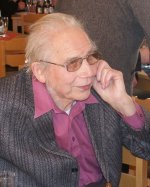 Heinrich-Gerhard Bücker at the New Year's Reception of the City of Beckum in 2008
Heinrich-Gerhard Bücker at the New Year's Reception of the City of Beckum in 2008Heinrich-Gerhard Bücker has created countless important works in the many decades of his artistic career and has thus gained great recognition in Germany and internationally. In this way, he has also made his hometown with the district of Vellern known far beyond the borders of Europe.
His work is characterised by the biblical-Christian world of symbols. For him, religion was the link between past and present, between "time and eternity", as the title of his last major exhibition in 2006 read. Thus, the focus of his work was in the field of sacred art. Since the 1950s, he has designed numerous church interiors in his unmistakable style. With his works, he set trend-setting accents for the emphasis of original styles by means of contemporary art.
His concern to create statements through the choice of form, colours and materials is always apparent. One of the highlights of his work was the exhibition of the drawings of his Bible volume "Alpha-Adam-Atom-Omega" in the Vatican Library in 1983/84. He was the first living artist to be allowed to exhibit there.
In addition to sacred art, he also created works of a profane character such as fountains and monuments. There are also numerous works of art by him in his home town of Beckum, to which he always showed great attachment, both in the town's churches and in public spaces. His research on the site of the Varus Battle has impressed many historians.
He has received many prizes and honours for his outstanding artistic work. Among others, he was awarded the Cross of Merit on Ribbon of the Order of Merit of the Federal Republic of Germany in 1983. In 1992 he was made an honorary citizen of the city of Beckum.
Dr Max Hagedorn
born 26.04.1904, died 24.12.1998
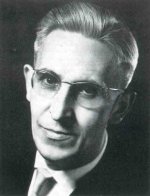 Dr Max Hagedorn
Dr Max HagedornDr. Max Hagedorn took over the office of mayor in January 1946 in an extremely difficult time. His untiring commitment to the common good earned him great recognition and he enjoyed the special trust of the people. High personal commitment, competence and his friendly and modest manner distinguished him during his 24 years as mayor.
Under the chairmanship of Dr. Max Hagedorn, decisive priorities were set in the Beckum town council for the positive development of the town after the Second World War. He was particularly committed to improving road conditions and to creating urgently needed housing for the many displaced persons, refugees and evacuees. Under his direction, the development measures in the city area and the drawing up of the first land use plan in 1958 were initiated. In addition, he was an exemplary advocate for the common good in various supra-regional committees.
Dr. Max Hagedorn received high recognition for his decades of service. In 1971, the Federal President awarded him the Federal Cross of Merit, First Class. The city of Beckum awarded him honorary citizenship on 24 March 1974, thanking him for his beneficial work for his home town.
Sister Maria Blanda, née Anita Bußmann
born 20.04.1898 in Buenos Aires, died 26.07.1980
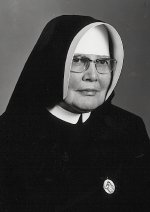
For 45 years Sister Blanda cared for and raised needy children from Beckum, the district of Warendorf and beyond in a beneficial and often self-sacrificing way.
Particularly great difficulties had to be overcome in the post-war period. Despite the most adverse circumstances, Sister Blanda cared for the children who had become parentless and partly homeless due to the turmoil of war, and who were accommodated in several building complexes of the former Vinzenzhaus, and gave them a new home. She was like a mother to these children, she gave them a home, brought them up with love and care and in this way successfully prepared them for their later path in life.
An important step in their work was the move of the children's home in 1953 to the newly built rooms on Paterweg.
The council of the town of Beckum unanimously conferred honorary citizenship on Sister Blanda at the festive meeting on the occasion of the 750th anniversary of the town on 26 March 1974.
Heinrich Haverkemper
born 19.02.1901, died 20.11.1989
Heinrich Haverkemper, a trained baker and confectioner and later a cement worker, joined the SPD as early as 1922 and was a member for more than 50 years. After the war, he rebuilt the party as chairman of the local SPD association. In 1945 he was appointed to the Beckum town council, where he served for 19 years, many of them as SPD parliamentary group chairman. He was also active in the district council for ten years.
He earned special merits as chairman of the Finance and Housing Commission. This task was particularly demanding in the difficult post-war years. Heinrich Haverkemper always had an open ear for the needs and concerns of those affected, such as refugees, and helped wherever he could.
Due to his many years of local political activity and his selfless commitment to the town of Beckum, he was awarded honorary citizenship on 26 March 1974.
Dr Ing. Curt Prüssing
born 26.03.1896, died 02.04.1988
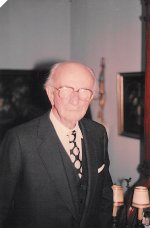
After graduating from high school, Dr Prüssing first studied chemistry at the University of Munich and began his career in 1922 as a scientific assistant at the Cement Technology Institute of the Charlottenburg Technical University. In the same year, he married Ilse Polysius, the daughter of Max Polysius from Dessau.
In 1924, Dr. Prüssing moved to Portland-Hemmoor AG and was appointed to the Managing Board in 1936. From 1936 to 1945, he was, among other things, Chairman of the "Association of German Portland Cement Manufacturers" in Berlin.
In 1946, Dr Prüssing founded Westpol GmbH under difficult conditions. From here he established relations with the former customers of Dessau-based Polysius AG. In just a few years, together with proven employees from Dessau, he succeeded in restoring the company, which had since been renamed Polysius GmbH, to a global reputation.
In 1962, Dr Prüssing decided to relinquish the management of the company and take over the chairmanship of the supervisory board, which he held until 1970. In this capacity, too, he made a major contribution to the development of Polysius into one of the largest engineering companies in Europe.
For his services to the economic development of the municipality of Neubeckum, Dr. Prüssing was awarded honorary citizenship by resolution of the municipal council in 1961.
Clemens Sprenker
born 26.01.1883, died 14.01.1968
Clemens Sprenker was mayor of the parish of Beckum from 1946 to 1961 and also mayor of the Beckum district from March 1946.
The council of the parish of Beckum decided on 28 April 1961 to make him an honorary citizen for his services to the parish of Beckum.
Alfred Moll
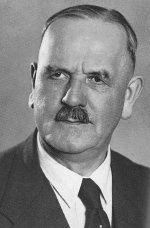
For 42 years, Alfred Moll, like his father Gustav before him, had rendered outstanding services to the development of Neubeckum as a member of the council.
He was appointed honorary citizen by the council of the municipality of Neubeckum on 10 December 1952.
Carl Fehling
born 07.04.1860 in Warburg, died 09.07.1933
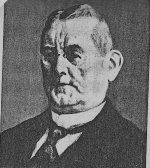
Fehling was elected mayor by the Beckum town council on 14 June 1899. Previously he had been mayor of Obermarsberg in the Sauerland.
The capable administrative official pushed ahead with the consistent municipal development and the adaptation to the economic, especially the industrial development of the district town.
During his 27 years in office, the district court was opened in Beckum, the tax office for the district was established, the slaughterhouse was built, the sewerage system was started, the first baths were built, the population was supplied with electricity and water, the grammar school was founded and the road building programme was started.
His work was crowned with the celebrations for the 700th anniversary of the town's charter in 1924.
After his retirement, he was made an honorary citizen on 11.10.1926.
Amtmann A. D. Theodor Anton Brüning
born 21.05.1822, died 30.03.1911
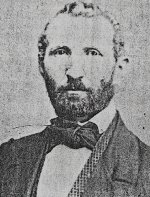
Theodor Brüning distinguished himself during the Kulturkampf through his courageous stand for the church, was sentenced to prison for a newspaper article and had to take his leave as Amtmann.
He was made an honorary citizen on 19.02.1906 "in appreciation of his faithful service in the interest of the city".
Medical Councillor Dr Ferdinand Anton Heyne
died 1906
Dr Heyne had earned a special reputation as a doctor in his commitment to public hygiene and was a member of the municipal council for many years. When he retired from the magistrate's office, he was awarded honorary citizenship on 13 June 1897.
Honorary Mayor
Two local politicians who have left their mark on Beckum
The former mayors Gerhard Gertheinrich and Aloys Gödde received the honorary title of "Honorary Mayor" at a special session of the Council on 14 June 1995 in appreciation of their many years of service as mayors.
Gerhard Gertheinrich
born 25 October 1930, died 1 May 1996
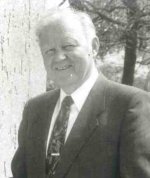 Gerhard Gertheinrich
Gerhard GertheinrichHe was committed to the common good in an exemplary manner for decades, always ensured a balance across all party lines and was extraordinarily popular with the citizens "as a mayor to touch". Gerhard Gertheinrich joined the SPD in 1961 and in the same year was elected to the representation of the then parish of Beckum, where he served until 1969, from 1962 as deputy mayor. Subsequently, interrupted by the period from 1979 to 1984, he was a member of the Beckum town council until 1995.
Gerhard Gertheinrich was mayor of the city of Beckum for 10 years from 1984 to 1994. He exercised this responsible office with foresight, great commitment and the ability to compromise across all party lines. At the same time he always remained a "man of the people" and thus approachable for everyone.
In addition, he also represented the town of Beckum on the administrative board of the Sparkasse Beckum-Wadersloh and on the supervisory board of the Beckumer Wohnungsgesellschaft.
His word also carried weight in the district of Warendorf. From 1979 to 1984 and then again since 1989, he was a member of the district council, which elected him first deputy district administrator in November 1994. He held this office until his sudden death in 1996.
His professional career was marked by a successful effort to achieve a fair balance between the interests of the employees and the company. As chairman of the works council, general works council and group works council as well as deputy chairman of the supervisory board of Dyckerhoff AG, he stood up for his colleagues and the company in equal measure as a member of the Chemical, Paper and Ceramics Industrial Union. Gerhard Gertheinrich's membership in the Workers' Welfare Association was also important.
In recognition of his great services to the common good, he was awarded the Federal Cross of Merit on Ribbon by the Federal President on 23 December 1995.
Aloys Gödde
Born 29 March 1933, died 25 April 2013
Aloys Gödde went down in history as the last mayor of the municipality of Neubeckum. He was appointed mayor at the young age of just under 30. This made him the youngest mayor in North Rhine-Westphalia at the time. This was followed by 11 eventful years in which he guided Neubeckum's fortunes in the best possible way. During this time, large building estates were created and the population grew enormously. The Roncalli School and the Kopernikus Grammar School were built. The building complex comprising the municipal library, leisure centre and senior citizens' day care centre enriched social life in the community and the construction of the tennis facility enhanced the range of sports on offer.Above all, however, Aloys Gödde was regarded as a mayor who was close to the people, who had an open ear for the concerns and needs of the citizens and helped many in difficult situations.
With the municipal reorganisation in 1975, Neubeckum was incorporated. Aloys Gödde had resisted this for a long time. Nevertheless, from 1975 onwards he contributed in many ways to Beckum and Neubeckum setting out to grow together.
In the transitional phase from January to May 1975, he was a commissioner of the council of the city of Beckum. In the first council of the new city of Beckum he was elected deputy mayor and held this office with one interruption for 9 years.
Until the end of his municipal political career in 1994, he was involved in the planning and transport committee and the Neubeckum district committee. He was also a member of the district council and the supervisory board of the Volksbank.
In 1994, he received the Federal Cross of Merit on Ribbon for his outstanding commitment.
Uri Avnery
Uri Avnery -
Israeli peace activist with Beckum roots
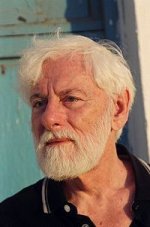
Uri Avnery was born Helmut Ostermann on 10 September 1923 in Beckum, in the house at Alleestraße 17, and lived in the "Püttstadt" until 1925.
He emigrated with his family to Palestine in 1933. The well-known peace activist has received several awards for his commitment to reconciliation between Israelis and Palestinians, including the Aachen Peace Prize in 1997, the Alternative Nobel Prize in 2001, the Carl von Ossietzky Prize in 2002 and the Lev Kopelev Prize in 2003.
Uri Avnery was publisher and editor-in-chief of the news magazine Haolam Haseh from 1950 to 1990. Between 1965 and 1981, he was a member of the Knesset for a total of about 10 years. In 1975 he was a founding member of the Israeli Council for Israeli-Palestinian Peace, and in 1993 he was one of the founding members of Gush Shalom, the Israeli Peace Bloc.
His grandfather Johannes Ostermann had been a teacher in the Jewish community since 1878. In addition, he held the sermons in the Beckum synagogue, as the small Jewish community in Beckum could not afford its own rabbi. The father, Alfred Ostermann, ran a small banking business in Beckum, which, however, faced increasing problems in the early years of the National Socialist movement. So the Ostermann family moved from Beckum to Hanover as early as 1925, where Helmut Ostermann also went to school. One of his classmates at the grammar school was the long-time editor of the "Spiegel" Rudolf Augstein.
The family had already sold the house at Alleestraße 17 to the Jewish doctor Dr. Walter Kronenberg before moving to Hanover.
Uri Avnery has been a guest in his native town of Beckum several times. For example, in 1995 on the occasion of the award of honorary citizenship to Rudolf Dunker and in 2005 when he presented his book "In den Feldern der Philister" (In the Fields of the Philistines) at a reading.
He passed away on 20 August 2018.
Street names
Origin and meaning of the street names
Street names tell a story
It is part of human nature to give a fitting and distinctive name to one's own soil. The old, popular street names of Beckum describe the soil (Steinbrink), the location in the countryside (Wersedreisch) or in the city centre (Nordwall). Historical events (Sachsenstraße), important traffic routes (Münsterweg), trading places (Roggenmarkt) or simply the name of a resident (Lönkerstraße) are also reflected in street names.Field names and squares
The names of fields, squares and paths are closely linked to the settlement history of a region and still provide an interesting insight into the peculiarities of the local past (Galgendreisch). While the field names designated one or more fields and were sufficient for a long time as a designation, the village community with its close coexistence required a parcelling of the inhabited area and thus also a division of the place and street names. Living space became even more cramped in the fortified towns of the High Middle Ages, where houses were also given their own name or later a house number.Points of orientation in the city
Many of the old street names came into being after the city actually became a city and are of folk origin. They were not written on the corners of houses (because not everyone could read), but were passed on orally over generations. Often the location of the street could also be deduced from the context, since a "Westwall" was always at the western end of the town and a "Windmühlenstraße" was probably near a windmill visible from afar. Thus, orientation was relatively easy despite the narrow development within the city walls.
Change through linguistic change
Colloquial usage sometimes changed or alienated the original meanings of the street names, some of which were even lost altogether. A not insignificant intervention was also the entry of the old names in the newly created cadastres by the "correct" Prussian officials, who did not want to let many a Low German name pass and invented a High German one for it according to law and order. Thus the two Beckum squares to the north and west outside the old town wall, where markets were held and which were called Füör-Märkte (Vormärkte) in Low German, suddenly became Feuer-Märkte (fire markets). They have survived to this day as Nordenfeuermarkt and Westenfeuermarkt.
New naming shows social change
While the street names in the centre are mainly of old origin, in the periphery there are some interesting namings from the second half of the 19th century that deal with the burgeoning economy. These include Schlenkhoffsweg, Westfaliaweg, Ladestraße and, last but not least, Kalkstraße and Zementstraße. In recent times, when the demand for street names has increased immensely, we encounter streets with the same name in many towns. Today, almost every larger town has its "Vogelviertel" or "Baumviertel", sometimes even a smiling "Mädchenviertel" with Prudentia-, Gertruden-, Klara- and Marienstraße.
The municipal reorganisations in many places also forced Beckum and Neubeckum to change historically grown street names. During the amalgamation, a total of 43 duplicate and 10 similar street names had to be renamed. It was agreed that the street with the largest number of residents would retain its original name.
Political propaganda
It is not unusual for the names of streets and squares to be used for political propaganda and to be renamed according to the changing flag. Under the National Socialists, Oststraße became Ostmarkstraße, Nordring became Memelstraße, Lehmkühlchen became Horst-Wessel-Platz, Elisabethstraße became Saarlandstraße, Nordstraße became Adolf-Schürmann-Straße (the first Nazi member of Beckum) and Alleestraße became Adolf-Hitler-Straße. Researching the old street names is thus still a contribution to the study of local history that should not be underestimated. As is so often the case, the truth is in the detail.Streets in Beckum
The year in brackets is the first official or presumed date of naming. Some names explain their meaning by themselves, for others a quick look in an encyclopaedia or a visit to our public libraries will help.
Ahlener Straße (before 1806)
The street begins at Westenfeuermarkt and leads to Ahlen. It is called Ahlensche Straße in the original cadastral map of 1806.Alleestraße (around 1900)
The street, lined alternately with red and hawthorn, and more recently also with Japanese ornamental cherry trees, circles the old Wallgärten (see Nordwall) together with Sternstraße. Under the National Socialists it was called Adolf-Hitler-Straße.Alsenstraße (around 1900)
Nothing further known.Alter Hammweg (possibly 14th century)
Trade route to Hamm in the direction of the Lippe ford near Uentrop. There, where it leaves the Beckum town field, stood the Hammwarte, similar to the Soestwarte (Höxberg), a fortified point of the old Landwehr. After a new road to Dolberg was built in 1824 (today's Hammer Straße), the former route was given the addition "Alt" (see "Auf dem Völker").Alter Posthof (28.05.1946)
The square behind the town house (Nordstraße 1) is a reminder of the former Samson'sche Posthalterei, whose postal operations began in 1814 under the management of the postmaster, innkeeper and mayor Johann Heinrich Samson.Altlomnitz Street (2009)
As a result of the Second World War, Altlomnitz, like almost all of Silesia, fell to Poland in 1945 and was renamed Stara Lomnica. The German population was expelled. More than 300 displaced persons came to Beckum. To commemorate this, an Altlomnitz memorial stone was inaugurated in the Westpark in 2002. To this day, the so-called Altlomnitzer Kirmes (Old Lomnitz Fair) is an annual traditional gathering of the Altlomnitzer in Beckum.Am Butterkamp (28.05.1946)
Kamp means enclosed arable or pasture land. The name can be interpreted popularly as a designation for a good cattle meadow, from which the cows gave particularly fatty milk. Butterkamp is mentioned as a field name in the cadastral map as early as 1831.Am Flachsberg (2006)
This name is based on the existing field name Flachsberg.Am Himmelreich (24.1.1958)
The name already appears in the land registers of the previous century. It refers to higher areas and good soil conditions.Am Hirschgraben (08.02.1928)
The low-lying wetland was formerly used as a horse pond and was still called Hersediek in 1441 or Am Herschteich in 1831. The Germanic word Hrossa or Hersa means horse. The Hersediek, literally horse pond, became the Hirschteich (deer pond) in later times.Am Kollenbach (08.10.1937)
Originally part of the cement road. It was a wooded area called Kollenbusch or Am Kolmer. It was partly boggy and swampy and had several springs that merged further on to form the Werse. The name of the stream has always adapted linguistically: Kollenbach was called Wesebecke in 1439, Weesebecke around 1695, Colmersbeck around 1760, Colmarsbeck and Colmaringsbach around 1800, and Kolmerbach in 1806. The names indicate that it is the Kollenbergsbach. The name Kollenberg is already known around 1279.Am Lippbach (30.03.1954)
The Lippbach is the third source river of the Werse. Around 1439 its upper course was called Spechtesbecke, around 1695 Spechtsbecke. The meadow and pasture area through which it flows in its upper course was still called Spechtskamp in 1957. The name Lippbach, which was not yet known at the end of the 18th century, refers to the old Lippweg, which led over the Lippberg and created the connection to Lippstadt.Am Rüenkolk (06.04.1956)
Named after the stream of the same name that flows into the Westteich. The cadastral map of 1831 calls the path "Am Rüren Kolchsgang" or "Rürenkolksgang". Rüeren or ruoren means to move violently, Kolk is the waterhole. Presumably it was a once vigorously swirling stream, which in dialectal simplification became Rüenkolk (Hundekolk).An der Christuskirche
Named after the Protestant parish church built in 1884.Annekestraße
Mathilde Franziska (3 April 1817 to 25 November 1884) was initially a writer of religious and literary works, published 3 almanacs with Low and High German literature (including by Annette von Droste Hülshoff), wrote poems, newspaper articles and a drama that was performed in Münster. Later she joined the "Democratic Association", where she met her future husband Fritz Anneke. She wrote a book entitled "Das Weib im Conflict mit den socialen Verhältnissen" and fought for political and social equality. After emigrating to the USA, she published the "Deutsche Frauenzeitung" there from 1852 and founded the "Verband Deutscher Frauen". In 1865 she founded a German-language girls' school, which she ran for 17 years.Anton-Schulte-Straße
Named after the Beckum local historian Anton Schulte (19.8.1905 - 18.8.1965), whose extensive studies led to the discovery of the Beckum princely grave in 1959 (see Sachsenstraße).Antoniusstrasse (around 1902)
The Nordenfeuermarkt, today Marienplatz (see also these two names), was used as a cemetery from 1817 to 1843. Until 1906, the Antonius Chapel stood there, after whose patron the nearby school was also named in 1902. The path from the chapel to Linnenstraße used to be called Kapellengang and was renamed Antoniusstraße. Only the ridge turret with the so-called "Swine-Tüns" has been preserved from the chapel (City Museum).On the Jacob (05.08.1954)
Nothing further known.Auf dem Völker (30.03.1954)
In 1477 the field is described as follows: "by dem Hammweghe, geheten die Völker". Further mentions are "de Volker by dem Hammwege" in 1480, "up den Volcker" in 1511, "up dem Voelcker" in 1521 and "auf'm Völker" in 1831.On the ramparts
deposits of dewy rock from quarries resulted in a hilly, undulating terrain.On Sonnenschein (11.02.1949)
In 1873, the company "Sonnenschein & Co" built 6 lime kilns near Stromberger Straße.Augustastraße
Named after the cement plant "Augusta-Victoria AG", which was started in 1912. It was never put into operation and remained a shell, as the operating company went bankrupt in 1914.Augustin-Wibbelt-Straße (27.08.1953)
The priest and dialect poet Augustin Wibbelt was born in 1862 on a farm near Vorhelm. After pastoring in various places, including Duisburg, he returned to his parents' farm in Vorhelm in 1935, where he died in 1947 (see also Wagenfeldstraße).Benno-Happe-Weg
Low German poet, born on 19 March 1880 in Beckum. Happe grew up here, became a postal worker in Coesfeld, Tecklenburg, Senden and Münster, among other places. He died in Münster on 1 July 1978.Bergstraße
At the place where Bergstraße once met the town wall was the Lütke (small) Windmühlenberg with the mill of the same name. It stood on the elevation of a plot of land that is still visible today, in order to get out of the lee of the town wall.Bonhoefferweg (20.12.1984)
Named after the Protestant theologian Dietrich Bonhoeffer (born 4.2.1906 in Breslau). Bonhoeffer had been director of the Confessing Church's preacher seminary since 1935 and was executed in Flossenbürg concentration camp at the end of the war on 9.4.1945.Borggrevestraße
In 1861-63, the building councilor F. A. Borggreve (died 1891) uncovered a burial ground from the 6th century in the south of the city (see Frankenstraße).Brinkmannstraße (16.05.1949)
Johann Bernhard Brinkmann (1813 in Everswinkel - 1889 in Münster) worked as a chaplain in Beckum from 1839-1853, later he was bishop of Münster. He was a close friend of Wilhelm Emanuel von Ketteler (see Kettelerstrasse) and supported him in the construction of the hospital in Beckum, the former Vinzenzhaus on Südstrasse. His memorial stone is located next to the west portal of St. Stephen's Church.Bruchstraße
Former quarry site.Christine-Koch-Straße
Village landlady in Bracht, Sauerland dialect poet, awarded the Claus Groth Prize, lyricist (23 April 1869 to 3 April 1951)Clemens-August-Straße (16.5.1946)
The street is named after Cardinal Clemens August Graf von Galen (1878-1946), who was also called the "Lion of Münster" because of his courage in confessing to the National Socialists (see Graf-Galen-Straße). The former Kolpingstraße, a part of the so-called Kleine Oststraße, received its name on 26 July 1928 and was named after Adolf Kolping (1813-1865), the founder of the Catholic journeymen's associations. The current Clemens-August-Straße was temporarily called "Sommerstraße" from the corner of Südstraße/Elisabethstraße to Kolpingstraße, before it became Clemens-August-Straße at the same time as the renaming of the Nazi streets. At the corner of Everkeweg and Paterweg is a bust of Cardinal von Galen. It was commissioned by Johannes Greiwe and Georg Rottmann from Heinrich Gerhard Bücker and erected in the mid-1960s.Dalmerweg
It leads to the farming community of Dalmer, which was already known as "Dalahem" in the 9th century. The owner of the main farm of this farming community was called "Schulte to Dalhem". "Dala" or "Dal" means valley, "hem" is equivalent to home or village. Thus "Dalahem" means the home or settlement in the valley. Since 1831 the street has been called "Dahlmerweg".Dechant-Schepers-Straße
Dechant Schepers (1870 to 1946) was the parish dean in Beckum. Among other things, he built the Liebfrauenkirche, the Marienstift, the Prudentia School and the Unterberg Chapel in Beckum. He also rebuilt the St. Elisabeth Hospital twice, extended the cemetery and created the Stations of the Cross in the cemetery.Droste-Hülshoff-Straße
Named after the Westphalian poet Anna Elisabeth Freiin von Droste Hülshoff (1797 at Hülshoff Castle near Münster until 1848 at Meersburg Castle on Lake Constance).Dr. Lönne-Straße (30.03.1954)
Sanitätsrat Dr. Lönne (1845 in Diestedde until 1903 in Beckum) was a popular doctor who was able to help numerous patients through his humour alone. He treated poor people and families with many children free of charge and is said to have even given them presents from time to time.Dr.-Max-Hagedorn-Straße
Dr. Max Hagedorn (26 April 1905 to 24 December 1998) assumed the office of mayor on 11 January 1946 and thus responsibility for the city of Beckum and its citizens in an extremely difficult time. Through his untiring commitment to the common good, Dr. Max Hagedorn earned high recognition among the population. High personal commitment, competence and his friendly as well as modest manner distinguished him during his 24 years as mayor. Under the chairmanship of Dr. Max Hagedorn, decisive priorities were set in the council of the town of Beckum for the positive development of the town after the Second World War. Dr. Max Hagedorn was particularly committed to improving road conditions, to development measures in the town area and to drawing up the first land use plan in 1958. He was involved in many subsequent development plans and was personally committed to the procurement of housing for the displaced persons, refugees and evacuees. Dr. Max Hagedorn understood his office as mayor as a service to the welfare of all citizens across party lines. On 21 April 1971 he received the Federal Cross of Merit 1st Class of the Order of Merit of the Federal Republic of Germany awarded by the Federal President. On 26 March 1974 he was awarded honorary citizenship of the city of Beckum.Dyckerhoffstraße
Named after Dyckerhoff AG, which in 1931 took over the cement plants of the Wicking Group in addition to its own (see Wickingstraße).Elisabethstraße
Saint Elisabeth (1207 to 1231), patroness of the hospital built in 1902 (first hospital founded in 1848).Elisabeth-Wibbelt-Straße
Elisabeth Wibbelt, (21 January 1856 to 16 May 1911 ) born in Vorhelm, is the eldest sister of the Low German regional poet Augustin Wibbelt. She wrote rapturous nature and love poetry, atmospheric, often simple images that evoke the longing for home, closeness, security and fulfilment; later she added numerous spiritual songs. Some of her works are kept in the Warendorf District Archive.Elisabeth-Selbert-Straße
Elisabeth Selbert (22 September 1896 in Kassel; until 9 June 1986 ibid.) was a German politician and lawyer. She was one of the four "mothers of the Basic Law" - the inclusion of equal rights in the fundamental rights section of the Federal German Constitution was largely due to her.Elise-Rüdiger-Straße
Elise Rüdiger (7 March 1812 - 31 January 1899) was a friend (correspondence) of Annette von Droste-Hülshoff and founder of the so-called "Literary Salon". She lived in Münster from 1833 to 1845 and wrote reviews, portraits, stories, novellas, and the like.Elmhof (1953)
The name recalls the name of the parcel "Elem" (see Elmstraße).Elmstraße (before 1806)
The original cadastral map of 1806 calls the area north of the railway between Oelder Straße and Wilhelmstraße "Große Elem" and east of Wilhelmstraße "Lütke Elem". Elem or Elm is the weathering product of marl. Around 1800 there was already a Lütke Elemsstraße, which is possibly identical with today's Elmstraße.Engelsgasse (around 1890)
Lane to the former Hotel zum Goldenen Engel. A connection with the Engelswiese (previously Lütkemühlenswiese), which was in the area of the later electricity plant, is uncertain.Esselenstraße
Court counsellor Conrad Moritz Friedrich Hermann Essellen (1796-1882) from Hamm was involved in the uncovering of the Frankish burial ground in Beckum together with the building counsellor F. A. Borggreve (see Frankenstraße and Borggrevestraße).Everkeweg
The Everke family can be traced back to the beginning of the 16th century in Beckum. The Beckumer Wilkor (first police order of 1592) was laid out by Stephan Everke (ca. 1540/50 - ca.1620), among others.Falkweg (20.12.1984)
The Falk family is one of the best known and oldest Jewish families in Beckum. One of the progenitors of the family, the cattle and horse trader Alex Falk (born on 9 January 1857 in Beckum), was so mistreated at the age of 81 during the Reichsprogromnacht from 9 to 10 November 1938 that he died on 11 November in a clinic in Münster.Feldstraße (around 1870)
A reminder of the Beckum Stadtfeldmark, which had existed since the High Middle Ages. As late as 1960, the area north of the railway line was still called Feldmark.Feuerstraße (25.10.1935)
See Lippborger Straße.Frankenstraße (14.04.1953)
A Frankish burial ground from the 6th century with 77 graves was discovered near this street between 1861 and 1863 (finds partly in the City Museum; see Essellenstraße and Borggrevestraße).Freiherr-vom-Stein-Straße (27.08.1935)
Karl Reichsfreiherr vom und zum Stein (1757 in Nassau - 1831 in Cappenberg/Westphalia), together with Hardenberg (see Hardenbergstraße), founded the Prussian reforms (peasants' liberation, town ordinance, freedom of trade).Freudenbergstraße (11.02.1949)
The name Freudenberg is not very old, but popular. In 1831, the southern slope of the mountain was called Hiddinghofer Berg, the northwestern one beyond Vorhelmer Straße Tuttenberg.Friesenweg (2008)
Due to the surrounding street names, the street now to be named should also be named after a Germanic tribe. It makes sense to name the street Friesenweg.Garden Street (around 1870)
Gerhardt-Gertheinrich-Straße
Gerhard Gertheinrich (usually called Gerd Gertheinrich) was born on 25 October 1930 in Neubeckum and died at the age of only 65 on 1 May 1996. The honorary mayor of the town of Beckum and bearer of the Federal Cross of Merit on Ribbon was a man who always had the common good in his home town of Beckum and in the district of Warendorf very close to his heart. The committed local politician was a member of the Warendorf district council from 1979 to 1984 and since 1989, which elected him first deputy district administrator in November 1994. For ten years, from 1984 to 1994, Gerhard Gertheinrich headed the Beckum council as mayor. He was a man of balance across all party lines and was universally popular as a "mayor to touch". For his great services he was appointed honorary mayor in 1995. Gerd Gertheinrich had been active in local politics since 1961. Initially he was a member of the parish council, then of the Beckum town council from 1969 to 1979 and from 1984 to 1995. His professional career was always marked by successful efforts as chairman of the works council, general works council and group works council and as deputy chairman of the supervisory board of Dyckerhoff AG to achieve a fair balance between employees and the company.Germanenstraße (31.03.1955)
See Frankenstraße.Gertrud-Bäumer-Straße
Gertrud Bäumer (12 September 1873 to 25 March 1954) studied German, philosophy, social sciences and theology in Berlin and received her doctorate in 1905 with a thesis on "Goethe's Satyros". She founded the "National Women's Service" with her friend Helene Lange during the First World War. Among other things, she wrote numerous writings on women's and family policy issues.Göttfricker Weg
Named after the Gotfredwich farm in today's Dalmer farming community. It was later called Gotferding and Götferk. A document from 1336 names a Friderikes to Gotferding, who had to pay dues to the bishop in Münster. In the cadastral map of 1806 the place is called Gottferker Weg, in 1831 it is called Goettferker Weg.Gottfried-Polysius-Straße
Named after Andreas Ernst Gottfried Polysius (27 November 1827 to 21 April 1886), son of a shepherd. The trained locksmith ran a small workshop in Dessau for 11 years, from which the "G. Polysius Eisengießerei und Maschinenfabrik" emerged on 23 May 1870. A report from the grammar school certified: "He can achieve something if he has the right will to do so.Graf-Galen-Straße
Named after Cardinal Clemens August Graf von Galen (1878 to 1946), the "Lion of Münster" (see Clemens-August-Straße).Gustav-Moll-Straße
The merchant Gustav Moll, who came from the Lenneper Land, is considered the founder of Neubeckum. There was even serious consideration of naming the municipality founded in 1899 "Mollstadt" in his honour. The name "Kalkheim" was also discussed at the time.Hammer Straße (after 1824)
After Beckum had received permission to build a road to Hamm, the section to Dolberg was completed by 1824 at a cost of 17,000 Taler, which had to be raised by the town alone. The entire route via Heessen to Hamm was completed in 1844 (see also Stromberger Straße).Hansaring (05.10.1954)
Beckum was affiliated to the Hanseatic League in the Middle Ages and was a transit town for goods traffic between Soest, Warendorf and the North German coastal region.Harberg (26.06.1984)
Named after the old name of the parcel "Harbergskamp".Hardenbergstraße
Named after the Prussian state chancellor Karl August Freiherr von Hardenberg (1750 to 1822), who, together with Stein (see Freiherr-vom-Stein-Straße), pushed through the Prussian reforms (peasant liberation, town ordinance, freedom of trade).Heddigermarkstraße
It led to the Mark Hedinghusen, where Heddiges Hof was located.Heinrich-Dirichs-Straße
Heinrich Dirichs was actively involved in the Beckum carnival and wrote many well-known song lyrics which were set to music by the musician and choirmaster Tönne Arnsberg and by the music teacher Heinz Füting. These songs (e.g. "Rumskedi, wie ist das Leben schön", "Wenn Rumskedi der Kater schreit") became real and repeatedly sung carnival hits. Heinrich Dirichs was also the editor of the carnival newspaper in the 1930s.
Heinz-Füting-Straße
Heinz Füting (1911 to 1967) was organist and choirmaster at St. Stephanus Church for 34 years. In 1949 Heinz Füting returned as a late repatriate, immediately resumed his work and at the same time became a music teacher at the Prudenziaschule in Beckum. The founding of the Beckum Music Association can also be attributed to his initiative. He also took over the direction of the folk choir in Ahlen. Heinz Füting made great efforts to promote public cultural life.Helene-Lange-Straße
Helene Lange (9 April 1848 in Oldenburg - 13 May 1930 in Berlin) was an educator and women's rights activist. She is a symbolic figure of the German women's movement.Hertha-König-Straße
Hertha Koenig (24 October 1884 - 12 October 1976) was a writer, patron and art collector. In the 1920s, together with Ricarda Huch, she was counted among the most important poets of her time. Her poetry was published by Insel, her prose by S. Fischer. Her circle of friends included Rainer Maria Rilke, Oscar Maria Graf, Martin Heidegger and Theodor Heuss.Herzfelder Straße (2nd half of 19th century)
The road leads through the farming community of Unterberg to Herzfeld. The cadastral maps of 1806 and 1831 call the road "Lutterbecker Weg" or "Lutterbecksweg" after its owner Lutterbeck-Schweppenstedde.Holtmarweg
It leads to the farming community of Holtmar, which was called "Holthem" in the 9th century. In 1831 it was still called "Holtmerweg" and led through the "Holtmerdreisch". "holt" means wood and forest, "hem" settlement and home (see Dalmerweg). Holtmar is thus a residence by the forest.Honerbergweg (before 1806)
The name "auf dem Honerberge" already appears in the cadastral map of 1831 and designates the area north of the Lippweg. The mountain had the name "Krieteberg" towards the town and "Honerberg" towards the outside. The names Honer and Kriete cannot be explained and possibly designate former owners.Hühlstraße (28.02.1928)
At the beginning of the 14th century, the land between Nordstraße and Nordwall was called "up den hule".Idastraße (11.02.1949)
Named after St.Ida (around 775 to 825) from neighbouring Herzfeld.Im Ensereck (26.06.1984)
Named after the old field name.Im Lehmkühlchen (25.04.1978)
The name is first mentioned in 1467. The cadastral map of 1806 calls the area around the Kettelerschule "Lehmkuhlendreisch", in 1831 "An der Lehmkuhle". The name Lehmkühlchen has survived in the vernacular to this day. Presumably a brickyard owned by the city was located there (see also Klarastraße).Jupp Rack Way
Jupp Rack was born on 24 March 1917 in Sorau (Silesia) and died on 29 September 1992 in Beckum. He came to Beckum in 1957 and joined the street musicians at an early age. Jupp Rack wrote songs and lyrics about the Beckum carnival, including "Ja, nun man tau", "Mit Pauken und Trompeten", "Heimweh zum Beckumer Karneval".Kalkstraße
Lime mining in Beckum since the 15th century.Kapellenstraße (14.04.1953)
The street is located near the Marienkapelle (Lady's Chapel) on the Alter Hammweg, popularly known as the Hammhäuschen.Katharina-Busch-Straße
More than 200 years ago, Katharina Busch (26 January 1791 to 2 November 1831) was born in Ahlen, grew up in Dülmen and moved to Münster in 1807. There, poet Matthias Sprickmann recognised her literary talent. Katharina Busch is described as Annette von Droste Hülshoff's teacher.Kettelerstrasse (08.02.1928)
Wilhelm Emanuel Freiherr von Ketteler (1811 to 1877) is one of the most important pioneers of the Church's social doctrine. He worked as a chaplain in Beckum from 1844 to 46. Numerous foundations in the town can be traced back to him. In 1848 he was involved in the foundation of the St. Elisabeth Hospital in Beckum. This is why there is a bust of Baron von Ketteler in the lift foyer of the hospital. It is a second cast of a work of art by Heinrich Gerhard Bücker. The original is the property of the Vatican. In addition, a memorial stone at the west portal of the provost church St. Stephanuskirche commemorates von Ketteler (see also Brinkmannstraße).Kirchplatz (12th century or earlier)
Designation for the square around the church. According to Charlemagne's decree at the imperial assembly in Paderborn in 782, the Christian dead were buried at the church houses of worship. Until 1817 the Beckum church square was used as a cemetery (cf. also Marienplatz and Nordenfeuermarkt). Around 1760, the square around the church was called "Domhoff".Klarastraße (21.04.1951)
Under the poplars on the Lehmkühlchen (see Im Lehmkühlchen) used to stand the St. Klara Chapel, which was demolished in 1840 because of its poor condition. During the Second World War, the Horst Wessel Kindergarten was built there, which was later renamed Klara Kinderheim.Kleine Südstraße (possibly from the beginning of the 14th century)
In 1831, the short road was only called Südstraße. Today's Südstraße was still called "Klosterstraße" in 1806 from the south gate to its centre (because it passed the Blumenthal monastery) and from there to the church square "Lütke Südstraße" (see Klostergasse and Südstraße).Kleypohlsgasse (before 1831)
Probably named after the Kleypoll family, which can be traced back to 1591 in Beckum. The small alley no longer exists today.Klostergasse (28.05.1846)
The narrow alley leads from Weststraße directly to the former buildings of Blumenthal Monastery (1446 to 1814), which were located on Klosterstraße (see Kleine Südstraße).Klosterkamp (14.04.1953)
Not identical with today's street. The name refers to the site on which the old, neo-Gothic St. Elisabeth Hospital was built from 1900 onwards. The land was originally owned by Blumenthal Monastery and was also called "Sutkamp" in 1806.Kreuzstraße (before 1885)
Originally Aleffstraße, named after the Jewish resident Aleff (15th century).Krügerstraße (08.02.1928)
Named after the doctor and Westphalian dialect poet Ferdinand Krüger (1843 to 1915), whose birthplace was in Beckum on Weststraße. A memorial stone with a portrait of the poet-doctor is located at the old defence tower in the Westpark. The path between the district administration office and the defence tower used to be called "Am Blockturm".Ladestraße (from 1879)
In 1879, Beckum received its own connection to the railway line running to the north, mainly because of the increased production in the lime and cement industries. The loading road names the place where the goods were loaded from the horse-drawn carts onto the railway wagons.Leisnerweg (20.12.1984)
Karl Leisner (28 February 1915 in Rees/Lower Rhine to 12 August 1945 in Dachau) was ordained a deacon on 25 March 1939 in Münster Cathedral. On 14 December 1940 he was deported to the Dachau concentration camp, where he was ordained a priest by a French bishop on 17 December 1944 (3rd Sunday in Advent). On 29 April 1945 he was liberated by Americans and died on 12 August of the same year as a result of his imprisonment. His body is buried in the crypt of Xanten Cathedral.Leutaschweg (2001)
Named after the Austrian village of Leutasch. There is a sponsorship between Leutasch and the Beckum Alpine Club Section. This sponsorship has resulted in numerous activities on both sides, so that there is a great bond between many Beckum citizens and the community of Leutasch.Linnenstraße (before 1831)
Originally Rodenstraße (16th century), which ran towards the so-called Rodenturm, one of the 22 defence towers of the city wall. Linen weavers and blue dyers settled in this street from the end of the 17th century until about 1870. Linnenstraße is mentioned in the cadastral maps in 1806 and 1831.Lippborger Straße (2nd half of the 19th century)
The street was still called "Soestweg" in 1806 and led from the East Gate to Lippborg. The section of Lippborger Straße that runs parallel to today's Soestweg used to be called Feuerstraße.Lippweg (before 1806)
The road begins at the Osttor and leads over the so-called Lippberg past the Galgendreisch to Lippstadt.Lise Meitner Way (2006)
Lise Meitner (7 November 1878 in Vienna to 27 October 1968 in Cambridge) went to Berlin as an assistant to Max Planck after studying physics and mathematics and completing her doctorate. In 1926 she became an associate professor. In 1938 she fled from the National Socialists as a Jew. In exile, she and her nephew provided the first theoretical interpretation of nuclear fission, for which Otto Hahn alone was awarded the Nobel Prize for Chemistry in 1944.Lönkerstraße (21.04.1951)
The street is located in the field "Auf dem Lönker". Here was the farm of the Schulzen Lovinghusen, which was once, like the Oberhof Bekehem, episcopal property. In 1287, the town leased the area from the Marienfeld monastery. The name developed as follows: 1287 "Lowichhusen", 1439 "to Lovinchusen", 1486 "to Loinchusen", 1509 "to Loynchusen", 1578 "up dem Loincker".Louise-Otto-Straße
Louise Otto (26 March 1819 in Meissen - 13 March 1895 in Leipzig) was a writer and co-founder of the German women's movement. She published articles in various journals (initially still under the pseudonym Otto Stern) and joined the democratic movement. In 1849 she founded the first journal of the German women's movement, the "Frauen-Zeitung für höhere weibliche Interessen" (Women's Newspaper for Higher Female Interests), which was able to appear until 1852 despite censorship measures. In addition to poems, Louise Otto also published novels, novellas, stories, opera libretti, historical writings, as well as numerous contributions on women's issues and history.Louise-von-Gall-Straße
Louise von Gall (19 September 1815 - 16 March 1855 ) is one of the women writers who made a name for themselves in German literature around the middle of the 19th century with her novellas and novels. Louise von Gall married the writer Levin Schücking in 1843.Luise-von-Bornstedt-Straße
In 1836, at the age of 30, Luise von Bornstedt (11 December 1806 to 3 September 1870) moved with her mother from Berlin to Münster. She was unmarried and had to earn a living for herself and her mother through writing and teaching, music and translations. She subsequently published poems, ballads, epigrams, novels, religious and historical works. In addition, she published individual poems and novellas in the Mindener Sonntagsblatt, the Rheinisches Odeon and other journals, which appeared in Berlin in 1853 under the title "Gedichte".Lohberg
The parcel on both sides of Dalmerweg was called "am Lohberg".Luise-Hensel-Straße
The poet Luise Hensel (30 March 1798 to 18 December 1876) only lived for a short time in the neighbouring town of Ahlen, from 1872 to 1874 with the Sisters of Charity in the Vinzenz Hospital, Kampstraße. Her poetry is considered romantic-pietistic and is counted among the most important religious poetry. Her most famous poem is the night poem: "Tired am I, go to rest...".Marie Curie Street (2006)
Marie Curie (7 November 1867 in Warsaw to 4 July 1934 in Sancellemoz/France) discovered the radioactive elements polonium and radium together with her husband in 1898 and was awarded the Nobel Prize for Chemistry in 1911 for this discovery. Both had already received the Nobel Prize for Physics in 1903 together with A. H. Becquerel. After her husband's death in 1906, she took over the chair of physics at the Sorbonne in Paris.Marienplatz (1909)
From 1817 to 1843 a cemetery at Nordenfeuermarkt, where the Antonius Chapel was located (see also Kirchplatz). After the chapel was demolished in 1906, the square was turned into green space, in the middle of which the Mariensäule was erected in 1909.Marienstraße (24.01.1958)
Named after the lands of the Marienfeld monastery, which were formerly located there (cf. Lönkerstraße).Market (12th century)
In the centre of the town, the trade and traffic routes cross. On market days, local or foreign traders, craftsmen and farmers offer their goods at this important junction.Martinsring (09.05.1972)
The area was still called "Auf dem Schmullort" in 1831 and was freed from the unattractive name due to a citizen's petition. The Wegschleife belongs to the Martinspfarre, after whose patron saint the nearby school and kindergarten are also named. In former times, the Geistkirche, dedicated to St. Martin, was located on the upper Weststraße. It belonged to the Great Spirit Hospital, which was founded around 1300. The so-called Martinsviertel is a reminder of this church, which fell victim to the great city fire of 1677. Its former location is recorded on the original cadastral map of 1806.Menni-Rosendahl-Straße
Dr. Menni Rosendahl (25 December 1908 in Beckum until 16 January 1989 in Beckum) was a dentist in Beckum for many years. He played the piano excellently and wrote and set to music the songs that have become folk songs: "Wer noch nie in Beckum einmal war", "In der kleinen Speckmannsgasse", "Hätt' ich doch Geld und vieles mehr".Mühlenstraße (18th century)
Originally the so-called Lütke Mühlenweg, which led to a water mill on the south-eastern part of the town wall. In 1792, according to a council resolution, a barley and grist mill was to be built there (see Schüttenweg).Mühlenweg (probably 16th/17th century)
Used to lead to the Lippe mill of Baron von der Recke on the Lippe river near Uentrop.Münsterkamp (June 1959)
The corridor through which the trade route to Münster led (see Vorhelmer Straße).Münsterweg (14th century)
The Münsterweg and the "Lütke Münsterweg" (today Vorhelmer Straße) led to Münster. Both paths joined at the edge of the Stadtfeld. The Münsterweg also included today's Münsterkamp in its course.Neubeckumer Straße (18.2.1930)
It was formerly called Steinweg, Geislerstraße and until 1930 Bahnhofsstraße. It connected Beckum with the Beckum/Ennigerloh railway station, from which the municipality of Neubeckum, independent until 1975, emerged in 1899. When the motorway was built in 1935, Neubeckumer Straße was further extended. The area at the motorway access road is still called Geißlerstraße today and leads through the borough of the same name.Nordenfeuermarkt (14th century)
The open space in front of the North Gate, called Marienplatz since 1909, was used as a cemetery from 1817 to 1843. Before that, trade was conducted here on market days, as it was on the market and the Westenfeuermarkt. In Low German, this place in front of the city walls is called Füör-Markt (Vormarkt), which was incorrectly changed into Feuermarkt (see also Westenfeuermarkt).Nordstraße (1238)
Like the Oststraße, Südstraße and Weststraße, designates the trade routes leading from the four main gates in a straight line to the market. Under the National Socialists, Nordstraße was called Adolf-Schürmann-Straße, named after Beckum's first NSDAP member.Nordwall (around 1830)
After the city wall had been largely demolished or destroyed in the 18th century, the ramparts in front of the wall were also levelled and gardens were laid out on them, the so-called Wallgärten. Later, today's Alleestraße (named around 1900) and Sternstraße (named from 1890) were built in front of the gardens. The east, south and west ramparts also mark the location of the old fortifications from town gate to town gate.Oelder Straße (before 1806)
The road from the North Gate via Vellern to Oelde, called "Oeldesche Weg" in 1806.Oststraße (1294)
See Nordstraße.Ostwall (c. 1830)
See Nordwall.Pannenberg (30.03.1954)
It is unclear whether there is a connection between the owner of the Pannenberg and that of the Pannkotten, which stood on Vorhelmer Straße in the 15th century. The cadastral map of 1831 names the area between Heddigermarkstraße and Lippborger Straße "Pannnenberg".Paterweg (08.02.1928)
Part of the path used to belong to the fathers of the Beckum canonry (1267 to 1812).Propsteigasse
Originally Kirchstraße, in 1967 the parish of St. Stephanus was elevated to a provostry.Processional Way
On the Sunday after the Feast of the Sacred Heart, the annual procession to the Lady Chapel on the Old Hammweg used to take the former field path.Prudentiastraße (24.01.1958)
Named after St. Prudentia, whose reliquary is in the Provost Church of St. Stephen. It is the largest and most important gold shrine in Westphalia and was donated by Beckum citizens around 1230.Pulort (after 1657)
The name only appears after the second Beckum fire disaster of 1657, but it is much older. The word Pul, Phuol or Phuhl stands for poles on which the first houses were built over swampy and boggy terrain. These "original inhabitants" are popularly called Paohlbürger.Rektor-Wilger-Straße
Heinrich Wilger (died 1931) took over as headmaster in Neubeckum in 1925. He promoted the development of the school system in the municipality for a long time.Rheinische Straße (01.04.1946)
On 30 March 1939, the settlement at Kollenbach was given the name Sudetenstraße. After the Second World War, the street was renamed in memory of the first Beckum cement factory, Rheinisch-Westfälische Industrie AG, founded in 1872. The factory buildings were already demolished in 1930.Richtersgasse (around 1890)
Residence of Judge Detten (18th century).Ring kilns
Ring kilns were used for burning lime. They appeared in the middle of the 19th century and replaced the so-called pot or field kilns, which had already been developed in the 18th century and were in use in the Beckum area until the end of the 19th century.Rye Market (before 1885)
In 1684, a municipal oil mill is said to have stood there next to another, privately operated mill. The street name recalls the old transhipment point for seed and grain. In 1831 it is still called Schultegasse. In 1885/86 already as Rye Market.Römerstraße (26.10.1912)
The street leads past the factory premises of the cement plant "Illigens, Ruhr- & Klasberg", founded in 1897. In contrast to "Westfalia AG", which was run by Jewish residents, and "Industrie AG", which was founded by Protestants, the factory, which was run by Roman Catholic residents, was called "Römer" for short.Rosenbaumweg (20.12.1984)
Oberfeldarzt Dr. Paul Rosenbaum, chief physician of the Ahlen military hospital, induced the Beckum combat commander Major Dunker to surrender the town to the advancing Americans without a fight on the night of Easter Sunday, 1 April 1945, thereby saving it from certain destruction.Rosengasse (before 1831)
Ruhrstraße
Named after the cement plant "Nord Ruhr & Co", founded in 1909, closed in 1969.Sachsenstraße
The so-called princely tomb of Beckum was discovered here in 1959. It is part of a large burial field and dates from around 600 (finds and documentation in the town museum).Sandkuhle (11.02.1949)
This was one of the oldest and most important sand pits in the city. The site was called "by der Sandkulen" in 1465, "de olde Sandkulen" in 1525 and "alte Sandgrube", "auf der alten Sandgrube" and "Am alten Sandgruben" in 1806 and 1831 respectively.Schlenkhoffs Weg (probably 1907)
Named after the ring and shaft kilns of the H. Schlenkhoff company, which were built along the Rattbach in 1907.Schüttenweg (21.02.1973)
Originally planned as a connection to Mühlenstraße (see Mühlenstraße). A document from 1456 calls the area "buten der ostporten by dem schuttewal" (Schützenwall). In the statutes of the Beckum Schützenbruderschaft of 1639 it is called "Schüttewall". In 1660 the area is called "am Schüttenwall".Sister Blanda Way (20.12.1984)
Sister Blanda (20 April 1898 to 26 July 1980) ran the municipal orphanage in the Vinzenzhaus on Südstraße as well as the newly built St. Klara children's home on Paterweg. She is an honorary citizen of the city of Beckum.Sister Waltraut Way (2002)
Sister Waltraut (4 June 1908 to 29 November 1988) was a dedicated parish nurse (deaconess) in the Evangelical Parish of Beckum from 1949 to 1978. In addition to her training as a parish nurse, Sister Waltraut had completed a full course of study in Protestant theology.Siechenhausweg
The road led past the former Beckum leprosarium (first mentioned in 1487), of which only the chapel remains. The nearby Siechenbach served as a water supply for the plague patients. In old documents, the stream is called "Bildewikerbecke" and is probably named after the Bildewik farm. On the cadastral map of 1831, the middle course bears the name "Elfortsbach". In 1862, the parcel was named "Siechenkamp".Sieverdingweg (20.12.1984)
Johannes Sieverding (17 November 1901 in Werth/Lower Rhine until 30 May 1981 in Flerzheim) was chaplain in the parish of St. Liebfrauen from 1939 to 1947. He supported the surrender of the city without a fight on the night of Easter Sunday, 1 April 1945 (see Rosenbaumweg). Sieverding later became pastor in Apeldoorn.Soestweg (11.02.1849)
The oldest designation of this important trade and military road to Soest dates from around 1300 and is "via Susaciensis". In 1440, the field name is "by dem Sostweghe" (see Lippborger Straße).Speckmannsgasse (before 1887)
Later "Niehaus-Gasse" and "Rauchgasse", named after residents.Steinbrink (05.10.1954)
The narrow road lies on an elevation near a quarry. Brink means raised grassy place.Steingasse (c. 1890)
Nothing further known.Sternstraße (around 1890)
See Alleestraße. Around 1890 only the section from Stromberger Straße to Wilhelmstraße bore this name, in 1928 also the section between Wilhelmstraße and Linnenstraße. In 1939 the upper part of the street was called "Straße der SA". The section from Linnenstraße to Nordstraße was still called Uhlengang around 1831. The area between Sternstraße and Antoniusstraße was still called "Am Umlauf" in 1831.Stiftsstraße (24.01.1958)
In this area were the ponds of the collegiate abbey, from which the abbey chapter supplied itself with Lenten food.Stromberger Straße (after 1837)
The second section of the planned causeway from Hamm to Wiedenbrück via Beckum (today's B 61; see Hammer Straße). It was completed in 1837 with a grant of 8,000 talers from the state treasury.Sudhofer Weg
The Sudhof was reached via this road. The Sudhof and Kalthof became the Boyenstein estate in 1845. In 1831 the area is called "Am Sutthoferwege".Südstraße (13th century)
See Nordstraße. Because of the marshy terrain (cf. Am Hirschgraben), the southern exit from the medieval town was not exactly to the south, for instance at today's Elisabethstraße (named around 1900), but further west at today's Dalmerweg, where the old gatekeeper's house on the Werse is still located. Today's Südstraße was originally called "Lütke Südstraße" (1831) and only ran as far as the branch of today's Kleine Südstraße. From there it was called "Klosterstrasse" up to the south gate (see Kleine Südstrasse and Klostergasse). The section of "Lütke Südstraße" was briefly called "Römer-Straße" in 1885/86.Südwall (around 1830)
See Nordwall. In 1831, the Südwall was called "Am Südteich" in the area of the so-called Bummelke and "Lütke Ostwall" south of the Marienstift.Tenkhoffs Gasse (before 1831)
Named after the residence of an old Beckum family.Thüerstrasse (around 1900)
Named after the historically unrecorded Beckum legendary hero "Thüer in de Müer", who is said to have killed the leader of the enemy troops, the Count von der Mark, with a single arrow shot in front of the west gate during the siege of the town, thereby persuading the enemy to retreat.Tönne-Arnsberg-Straße
Anton Arnsberg was commonly called Tönne Arnsberg. He was born on 25 April 1884 and died on 23 November 1976. He was organist and choirmaster at St. Stephanus Church and conductor for many years at the local Sängerbund. He set the well-known carnival songs "Rumskedi, wie ist das Leben schön", "Wenn Rumskedi der Kater schreit" and many other songs to music.Tümlerstraße
Named after the former Vellern pastor and naturalist Bernhard Tümler (1832 in Münster until 1916 in Vellern).Vierweidenweg (24.04.1951)
Probably named after a group of willow trees that stood between the Kollenbach and the upper Stromberger Straße. The field name in 1862 is "Verwiedendreisch", indicating a front and a rear Vierweidendreisch. The oldest names are "by den veer weyden" in 1460, "by den IIII weyden" in 1506, "by den veer weyden" in 1525 and "up den Verwyden" in 1549.Viktoriastraße
Named after the Auguste Viktoria AG cement plant, which was started in 1912 but never completed.Von-Hohenhausen-Straße
Henriette von Hohenhausen (22 October 1781 - 20 April 1846) was the aunt of Droste's friend Elise Rüdiger. She wrote stories, poems and youth writings with a religious orientation.Von-Vincke-Straße (27.08.1953)
Named after Georg Freiherr von Vincke (1811 to 1875). The Prussian politician was the leader of the far right in the Frankfurt National Assembly of 1848. The street was previously called Senkelkuhle (official naming on 11 February 1949). The name can already be found on the cadastral maps of 1806 and 1831 ("Am Senkerkuhle"), but is probably much older. Senkel, originally Senker, is a building material that was used to fill in the wattle and daub of half-timbered houses. At the request of a citizen who was ashamed of the "Kuhlenname", the street was renamed Von-Vincke-Straße.Vorhelmer Straße (2nd half of the 19th century)
The old trade and army road was still called "Lütke Münsterweg" in 1831 (see Münsterweg). It came into being with the construction of a road connection from the North Gate to Münsterweg.Walkerberg
The Walkerberg is another slope of the Pannenberg and was named after the Walewic farm, which the town leased from Liesborn Monastery as early as 1238. The parcel is called "Am Walkerberge" in 1831.Wersedreisch (before 1831)
The street runs through the old Wesingdreisch. Dreisch, Driesch or Dreesch means fallow, uncultivated land. Wesing goes back to the Schulzenhof on the Werse, the Wesinck- or Wessinghof (hence Wessingweg), which was near the Wersemühle. The oldest form of the Wersedreisch from 1509 is "Wesinckdreisch".Wessingweg (before 1831)
See Wersedreisch.Westenfeuermarkt (14th century)
See Nordenfeuermarkt. The cadastral map of 1831 calls the area of today's Westpark "Schweinemersch". The Westenfeuermarkt was actually in the area of Münsterweg.Westfaliaweg (11.02.1949)
Named after the "Portland-Zement- und Wasserkalkwerk Westfalia AG" founded in 1884 (cf. Römerstraße). The former railway station Beckum-Ost also bore the name Westfalia.Westfälische Straße
Named after the first Beckum cement plant "Rheinisch-Westfälische Industrie AG", founded in 1872.Westhöfe (25.11.1971)
Named after the Vellern farms Große Westhoff and Kleine Westhoff.West Street (1238)
See North Street.Westwall (c. 1830)
See Nordwall.Wickingstraße
Named after the Wicking Group, which took over the following cement plants in the Beckum area from 1917: 1917 Roland AG, 1921 Port-Union-Westfalia AG (resulting from the merger of Porta-Union AG with Westfalia AG) and Mark AG, 1926 Zollern AG, Rheinisch-Westfälische Industrie AG, and Grimberg & Rosenstein AG, 1929 Schlenkhoff AG. The group was taken over by Dyckerhoff AG in 1931 (see Dyckerhoffstraße).Wilhelmstraße (around 1900)
Named after the last German Emperor Wilhelm II (1859 to 1941). It was previously called Bühlstraße (named around 1530) after the nearby Boddels- or Bulsturm. The name Buddelstraße is documented for 1655, Büttelstraße for 1769 and Büttstraße for 1831.Windmühlenstraße (17th/18th century)
The copperplate engraving of the town of Beckum by Merian (1647) shows a mill on a hill in front of the east gate. There is also written evidence of it in 1664. In 1751, the wooden mill was demolished and replaced by a stone one. After its collapse, a new building was erected in 1810, which was in need of repair after two fires in 1839 and 1876. Around 1850, the mill was extended so that it could also grind barn barley (pearl barley). The mill was still in operation after the Second World War.Windmüllerkamp (20.12.1984)
Former pasture land of the Jewish cattle dealer Philipp Windmüller, Weststraße. The street name is representative of all Windmüller families who lived in Beckum until 1939.Wittekindstraße (30.09.1975)
Actually Widukind (died around 804/812), a Saxon prince of Westphalian nobility who fought against Charlemagne (see Frankenstraße).Cement road (after 1872)
The road led to the cement factories "Rheinisch-Westfälische Zementindustrie AG Köln" and the companies Horstkötter & Illigens and Bomke & Bleckmann, located on the Kollenbach. The road was originally privately owned by the first-mentioned cement factory, which transported its cement to the railway station via this route.Zollernstraße
Named after the Zollern AG cement plant, founded in 1908.Minerals and fossils
On the following page, private individuals have compiled valuable information for you:
Minerals and fossils
